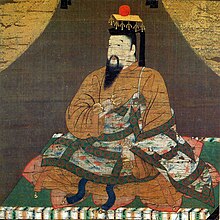
Back قودایقو (ایمپیراتور) AZB Go-Daigo Catalan ئیمپراتۆر گۆ-دایگۆ CKB Go-Daigo Czech Go-Daigo German Αυτοκράτορας Γκο-Ντάιγκο Greek Go-Daigo Tennō Spanish امپراتور گودایگو Persian Go-Daigo Finnish Go-Daigo French
| Emperor Go-Daigo 後醍醐天皇 | |||||
|---|---|---|---|---|---|
 | |||||
| Emperor of Japan | |||||
| Reign | 29 March 1318 – 18 September 1339 | ||||
| Enthronement | 30 April 1318 | ||||
| Predecessor | Hanazono | ||||
| Successor | Go-Murakami Kōgon (pretender) | ||||
| Shōgun | Prince Morikuni Prince Moriyoshi Prince Narinaga Ashikaga Takauji | ||||
| Born | 26 November 1288 Heian-kyō, Kamakura shogunate | ||||
| Died | 19 September 1339 (aged 50) Yoshino no Angū (Nara), Ashikaga shogunate | ||||
| Burial | Tō-no-o no misasagi (塔尾陵) (Nara) | ||||
| Spouse | Saionji Kishi Junshi | ||||
| Issue among others... | |||||
| |||||
| House | Imperial House of Japan | ||||
| Father | Emperor Go-Uda | ||||
| Mother | Fujiwara no Chūshi | ||||
| Signature | |||||
Emperor Go-Daigo (後醍醐天皇 Go-Daigo-tennō) (26 November 1288 – 19 September 1339) was the 96th emperor of Japan,[1] according to the traditional order of succession.[2] He successfully overthrew the Kamakura shogunate in 1333 and established the short-lived Kenmu Restoration to bring the Imperial House back into power. This was to be the last time the emperor had real power until the Meiji Restoration in 1868.[3] The Kenmu restoration was in turn overthrown by Ashikaga Takauji in 1336, ushering in the Ashikaga shogunate. The overthrow split the imperial family into two opposing factions between the Ashikaga backed Northern Court situated in Kyoto and the Southern Court based in Yoshino. The Southern Court was led by Go-Daigo and his later successors.
This 14th-century sovereign personally chose his posthumous name after the 9th-century Emperor Daigo and go- (後), translates as "later", and he is thus sometimes called the "Later Emperor Daigo", or, in some older sources, "Daigo, the second" or as "Daigo II".
- ^ Imperial Household Agency (Kunaichō): 後醍醐天皇 (96); retrieved 2013-8-28.
- ^ Ponsonby-Fane, Richard. (1959). The Imperial House of Japan, p. 95.
- ^ Sansom 1977: 22–42.